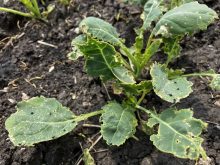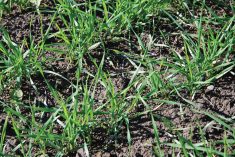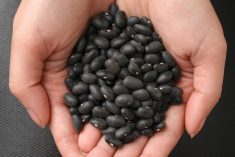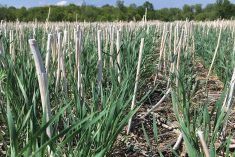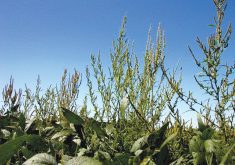The first soybean aphids of the season have been found near Morden but there are so few and it’s so late they are unlikely to be an economic pest this season, says Manitoba Agriculture, Food and Rural Development’s entomologist John Gavloski.
“It’s happening very late so there could be some later-seeded fields that are still susceptible, but as far as we know they have just arrived, or at least they are just being noticed,” Gavloski said in an interview Aug. 13.
Read Also

Manitoba sclerotinia picture mixed for 2025
Variations in weather and crop development in this year’s Manitoba canola fields make blanket sclerotinia outlooks hard to pin down
“And right now they are at very low levels. A person would have to look very hard to even find some. We’re nowhere close to the 250 per plant (and rising) threshold (for spraying an insecticide for control).”
Soybeans are most at risk from soybean aphids in the R1 (beginning to bloom) to R 5 (small seed development) stage Gavloski said earlier during the Westman Crop talk webinar.
“Once the seeds are full size it’s probably too late to be worrying about soybean aphids,” he said. “It’s when the seeds are smaller and developing that soybean aphids can be an issue.”
Whether soybean aphid populations increase enough to cause economic damage depends on several factors, including the activity of natural insect and disease predators, he said. Both agronomists who reported the soybean aphids said they saw more predators than aphids.
“My gut feeling is it likely won’t be an economic issue this year given how late they’ve arrived and the fact there does seem to be some healthy natural enemy populations around,” Gavloski said.
- From the Grainews website: Check the bertha map, and if it looks like an alligator, leave it

Those include lady beetles in the larval and adult stage, pirate bugs, lacewings, certain wasps and a fungal disease. Larger lady beetle larva can eat 100 aphids a day.
“That really helps,” Gavloski said.
Soybean aphids don’t overwinter in Manitoba because it’s too cold. They blow in from the United States, but once here, under the right conditions, can double their population in a week.
Soybean aphids on the back of a soybean leaf. The white spots are discarded soybean aphid skins. The economic threshold for spraying to control soybean aphids is 250 aphids per plant and rising.
Partial leaf count
When soybean aphid numbers are high counting isn’t practical, Gavloski said. It’s better to count the number of insects on part of a leaf and use that to extrapolate. A number of plants should be randomly selected and the estimated number of aphids averaged. MARFD has designed an online photo key called the “Soybean Aphid Counting Card” to assist.
Be careful not to count aphid skins discarded as the insect goes through various stages. The cast skins look a bit like dandruff, Gavloski said.
“Don’t get panicky if start to see on average 50 aphids per plant,” he said. “Soybeans can tolerate that quite well, especially if we have decent growing conditions.”
While the economic threshold triggering an insecticide application is 250 soybean aphids per plant, research shows there’s no yield loss until populations hit 485 to 600 aphids per plant, Gavloski said. It takes 670 aphids per plant to cause enough yield loss to cover the cost of applying an insecticide. Two hundred and fifty aphids per plant and rising is the trigger because even if an insecticide isn’t applied for a week it will be in time to prevent lost yield, he said.
“This is the reason you don’t lower the threshold below 250 (even if soybean prices increase) because you’ve already got some distance between 250 and the level of where you can detect any yield loss,” Gavloski said.
“There’s no reason to have an economic threshold lower than your damage boundary where no yield loss occurs and that’s regardless what the price of your soybeans are.”








